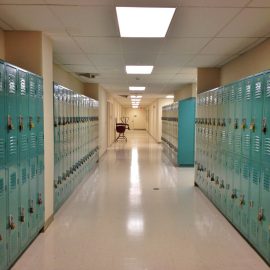Education & Family
The Perfect Fit
Here’s our primer on navigating the independent-school application process and making the right choice for your child.
Open House Schedule sponsored by Beth Tfiloh
With three children who have been through the independent-school application process, Susan Miller and her husband, Scott, have become veterans of the school selection and admission ritual. Their youngest child, 15-year-old Jack, entered the ninth grade at Loyola Blakefield this fall. But the Millers’ history with independent schooling goes back 14 years, to when their oldest son, Bryan, now 21 and studying at the University of South Carolina, started kindergarten at The School of the Cathedral of Mary Our Queen.
Susan, a product of public schools, and her husband, who attended Catholic school as a child, decided on Cathedral for their son after looking at Immaculate Conception School and Cromwell Valley Elementary Regional Magnet, as well as local public schools, and based the decision on a combination of price, location, academics, religion, and facilities.
But before starting the selection process, parents must make another important decision: whether independent schooling is right for their child.
“I recommend that parents start by thinking about what their child needs in a school,” says Myra McGovern, National Association of Independent Schools (NAIS) spokesperson. “Would the child do best in a small, close-knit community, or in a community with a larger circle of friends and acquaintances? Does he or she have special interests that you’d like to nurture or challenges that you’d like to address?”
Luckily, Baltimore has diverse educational options for every type of child. About 11,400 students attended 19 independent schools in the greater Baltimore area for the 2013-2014 school year, according to NAIS. And despite a roughly 4 percent student population decline in Baltimore City since 2010, about a quarter of independent schools in the greater Baltimore area have seen enrollment growth during that time.
Once Bryan was happy at Cathedral—and the parents were convinced, too—the Millers’ decision to also enroll their two younger children, Sarah and Jack, was easy. But the bigger challenge came when Bryan reached fifth grade and began the search for middle school. Although the family visited open houses for several schools, including St. Paul’s School and The Boys’ Latin School of Maryland, Bryan’s interest in Loyola Blakefield came from another area, club sports, since he’d played in practices and games there.
But despite his familiarity with the school, the Millers pushed their son to visit other schools and shadow at Loyola before making the final decision.
Shadowing, when a prospective student accompanies a current student for all or part of a school day, is one step in the selection process that admission directors recommend families begin a year in advance.
Why start so early? Although many families will form opinions about schools before it’s time to start the formal application process, it’s a good idea to begin with an open mind. Look at school websites so you’ll know which open houses you want to attend in the spring.
“An open house is an introduction,” says Ron Goldblatt, executive director of the Association of Independent Maryland & DC Schools (AIMS). Because open houses are often on the weekends, it’s a convenient time for working parents to learn more about a school. But because you don’t see the school in action, open houses alone aren’t enough to make a decision. Rather, he says, the events are a chance to ask, “‘Have I heard enough to want to follow up?’ It’s merely a scratching of the surface.”
Shadow days provide hands-on insight for the prospective student, which can give parents an idea of how their child will fit into the school’s culture. The best way for parents to get a genuine feel for a school is to sit in on classes, Goldblatt recommends.
A typical school visit may include a tour, meeting some students, and conversations with teachers and administrators, but there are other ways to get a feel for the day-to-day environment. “Get off the beaten path and go unscripted,” says Goldblatt, former headmaster of The Key School in Annapolis. “Suggest to the admissions office, ‘I’d like to spend a half hour in the halls, sit in a class you didn’t choose.’”
While not all schools may be able to accommodate the request, it’s a good way to see the school in action.
When choosing a middle school for their daughter, Sarah, the Millers looked for a close-knit school that would provide individual support. After looking at several schools, they decided on St. Paul’s School for Girls, a private school for girls grades 5 through 12, from which Sarah graduated in the spring, before heading off to Elon University.
It was the special learning programs offered by St. Paul’s that made the school the right fit. “St. Paul’s has a learning specialist that has been a godsend to us,” says Miller. The individual attention helped her daughter thrive at the school, and diverse programs, like a choir trip to Ireland in her junior year, gave her memories she’ll never forget.
“St. Paul’s was a very nurturing school. The girls are all giggling in the halls—she loved it.”
Although many parents let the final decision rest with their older children, finding the right match isn’t so easy with young children who can’t make the decision on their own.
Dawn Cofiell, the mother of three children—Donovan, age 7, Brayden, age 6, and Kaitlyn, age 4—instead asked lots of questions and got to know the teachers and administrators of the school she was considering for kindergarten, St. Ursula School, which offers coeducation from pre-K through eighth grade.
To choose the best kindergarten, Cofiell attended open houses and classroom visits. Two major factors in her decision were price and continuity—she wanted all three children to attend the same school and avoid multiple school transitions before high school—as well as religion and the quality of the instruction.
Another important factor was academics—Cofiell wants her children to be prepared for rigorous high schools. “A lot of kids that graduate [from St. Ursula] go to Calvert Hall [College High School], Loyola, those kinds of schools. They mold them for where they’re going to go eventually,” she says. “I don’t want to look back and say, ‘I wish I would have.’ You only get one chance.”
Acing Admissions
Tips from Gilman’s director of admissions.
Applying to independent schools is a process—there’s much more to it than simply calling up the school and enrolling your child.
“It’s certainly an assumption we all get at independent schools,” says Bill Gamper, director of admissions and financial aid at Gilman School. “The process at many of the schools is similar, but it’s rarely the same.”
Gamper recommends that families begin the admissions process the spring before the application cycle, when admissions offices will be less busy and a tour can be arranged. “In the early fall, the family should begin the process in earnest and try to have all aspects complete before the holidays roll around,” says Gamper.
And who should make the final decision, the child or the parent? “For early ages, the parents are and should be the decision-makers. They know their child and they can discern what might be the best fit,” says Gamper. “When you’re getting into high school, many parents simply leave the decision to their 14-year-old.” For this reason, Gilman educates the prospective high school student as much, if not more, than the parent.
Beginning with middle school, peers play a larger role in a child’s choices. While children often want to remain with their current friends, “A student ought to be mindful of what’s best for him,” says Gamper. “Saying that to a 14-year-old is not always simple.”
Shadow days help older children see how they would fit into the school’s culture. “We feel strongly that an applicant should shadow,” says Gamper.
The often-lengthy admissions process (Gilman requires Independent School Entrance Exam test scores, teacher referral forms, transcripts from the current school, and parent and teacher interviews) is as much to see how your child will fit at the school as it is to see if the school is a fit for your child.
For Gamper, it all boils down to finding the right place. “That’s what families have got to do: recognize that their children are going to find the place where they’re going to be the most successful in an environment conducive to their strengths and supportive of their weaknesses,” he says.
And rejection sometimes has more to do with the space available than it does with how well the child would do at the school. For this reason, it’s a good idea to have a few options you’ll be happy with.
Luckily, Baltimore has plenty of schools to choose from.
Facing the Financing
Funding an independent-school education.
With the median Baltimore-area day-school tuition ringing in at $23,846 for the 2013-2014 school year, there’s more for parents to worry about than the application.
Financing an independent school education is a daunting task. But schools are adding more programs to assist parents and deserving children.
Last year, more than 32.3 percent of Baltimore-area students received financial aid, with a median award of $4,100. Since offerings vary by school, check with the financial-aid office during the application process.
Don’t think you’ll qualify? “It doesn’t hurt to apply,” says Tom Travers, director of financial aid at St. Paul’s School for Girls. “Communicate with the school’s admissions office to determine if there are any merit-based scholarships available for their application.” St. Paul’s School for Girls offers two different types of academic scholarships, available at the middle and upper school levels.
Since most schools have a very limited financial-aid budget, it’s important to turn in all application materials on time.
At St. Paul’s School for Girls, about 30 percent of the students receive financial aid, and the awards range from 10 to 95 percent of total tuition, depending on the need.
Schools are committed to helping families afford independent education. Some members of the Association of Independent Maryland & DC Schools (AIMS) offer low-interest loans or partner with financial agencies to provide interest-subsidized loan programs.
Most Baltimore-area schools offer options that make paying the bill easier, regardless of financial need. St. Paul’s School for Girls has an interest-free monthly payment plan (after a one-time fee of $75), which many families find more affordable than a lump payment.
Parental Guidelines
The National Association of Independent Schools suggests that parents ask the following questions as they look through each school’s materials:
- Is the school accredited and by whom?
- What is the school’s mission and does its philosophy appeal to you?
- Does the school have a special or particular educational focus?
- Are academics rigorous?
- Is the environment competitive? Nurturing? Are there high expectations?Does the school meet your child’s needs?
- How large is the school and its student body?
- Where is the school located and what are your transportation options?
- Does the school seem to have a diverse student body and faculty?
- Do the school materials discuss parental involvement?
- For high schools, what are the graduation requirements? What percentage of students enters college-—and what kind of colleges do they attend?
- Is college counseling effective? (Look at the rates at which school grads achieve their first and second college choices.)
- What is the tuition and how flexible are the school’s financing options?
Beyond The Open House
If the glossy brochures, open houses, and school visits are making your head spin, try these alternative ways to learn more about a school.
Summer programs: Many schools offer summer programs that give a taste of the school’s culture long before it’s time to think about the application process. Try The Bryn Mawr School’s Little School Summer Camps for boys and girls ages 3 through 5, or Friends School of Baltimore’s Kindercamp for 4- and 5-year-olds.
Word-of-mouth: When asking others’ opinions of a school, you’re likely to hear both good and bad. But when selecting a school for your child, people you know are a great place to start. Neighbors, coworkers, and family members with ties to the school are great resources, as parents, teachers, and alumni can give you insights into a school’s inner workings.
School events: Extracurricular activities will define your child’s school experience just as much as academics, so why not check out what schools have to offer? Whether it be sports games and theater productions or art shows and community events, get your child on a school’s campus for a glimpse of programs he or she may someday join. Visit the annual Gilman Christmas Tree and Bake Sale, or the annual Turkey Bowl lacrosse game between Calvert Hall and Loyola Blakefield for a taste of a historic rivalry.
George Washington Studied Here
Ask a few schools about their famous grads, and here’s what you might hear.
Baltimore School for the Arts: Eric Greene, class of 1992, has sung with some of the principal opera companies of Europe and America including the Chicago Lyric Opera, the Los Angeles Opera, the San Francisco Opera and the New York City Opera. Violist Nadia Sirota, class of 2000, was hailed by Time Out New York as one of New York’s “brightest, busiest players.” Project Runway champ Christian Siriano, class of 2004 created a line of make-up for Victoria’s Secret and a bridal collection for Nordstrom as well as several of the Emmy Awards dresses that ended up on best-dressed lists this year.
The Boys’ Latin School of Maryland: Outstanding alumni include Pulitzer Prize winners Hanson W. Baldwin ’20 and James Murray Kempton ’35; Dr. Arthur L. Bloomfield, 1904, a pioneer in the use of penicillin; and Alfred H. Barr, 1918, founding director of The Museum of Modern Art.
Calvert Hall: Juan A. Dixon ’97 led the University of Maryland Terrapins to their first NCAA championship in 2002 and earned Most Outstanding Player honors at the 2002 Final Four. The school also boasts a Maryland governor’s chief of staff (Matthew D. Gallagher ’90) and a top 10 finalist on America’s Got Talent (Drew Stevyns ’98).
Friends School of Baltimore: Dr. Jonathan Patz ‘76, was lead author of the Intergovernmental Panel on Climate Change, which shared the 2007 Nobel Peace Prize with former Vice President Al Gore. Other noteworthy alumni include Tucker Taylor ’57, part of the original management of Fed Ex, and Lance Reddick ’80, an actor known locally for playing Lt. Cedric Daniels on The Wire.
Gilman: Bespectacled Gilman student Walter Lord won an award as a senior in 1935 for his speech on the sinking of the Titanic. Nineteen years later, he published A Night to Remember, a book read by millions that has never been out of print. Some would say he created the narrative history genre.Charles C. Fenwick Jr. ’66 was winner of the Grand National—the world’s greatest steeplechase—in 1980 riding Ben Nevis. More recently, Fenwick, now president of Valley Motors Auto Group, participated in the Aintree Legends Charity Race at the 2011 Grand National in Liverpool, England on April 9. The celebrity race featured 10 Grand National winning jockeys. Another Gilman grad, Doug Becker ’84, has been chief executive officer and chairman of Laureate Education since 2000. Becker, who never attended college, led the transformation of Laureate Education (formerly Sylvan Learning Systems) from a domestic tutoring provider into the world’s leading international higher-education company with operations in more than 15 countries.
Loyola Blakefield: Graduates include the late Thomas L. Clancy Jr. ’65, author of such novels as The Hunt for Red October and Patriot Games, whose work has been adapted to film and video games. The Reverend George Coyne ’51 was the longtime director of the Vatican Observatory, and Thomas Hecht ’78 is a world-renowned pianist and head of piano studies at the Yong Siew Toh Conservatory of Music in Singapore.
Maryvale Prepatory School: Maryvale graduate Patty Brown ’78, is president of Johns Hopkins Healthcare and senior counsel for The Johns Hopkins Health System. Suzanne Fischer-Huettner ’91 is publisher of The Maryland Daily Record.
McDonogh: Henry Laurence Gantt, a member of the class of 1878 (and one of the school’s original 21 students), created what became known as the Gantt chart, a project-management tool similar to a sideways bar graph. A more contemporary grad, Jenn Wasner ‘04, is a member of the up-and-coming band Wye Oak.
Notre Dame Prep: Notre Dame Prep grad Brigadier General Elizabeth Hoisington ‘36, was the second woman brigadier general in the U.S. Army. Corinne Raphael Sweeney ’71, is a veterinarian who ministered to 2006 Kentucky Derby winner Barbaro after he shattered his leg in the subsequent Preakness Stakes. The Honorable Catherine “Katie” Curran O’Malley ’81, is a Maryland District Court judge, daughter of former state Attorney General J. Joseph Curran Jr., and wife of Governor Martin O’Malley.
The Park School: Park’s Rothman Brothers (John Rothman ‘67 and Tom Rothman ‘72) have made names for themselves in entertainment: John is an actor who has appeared in Law and Order and Arrested Development as well as the Broadway revival of Prelude to a Kiss, and off-Broadway in his one-person play The Impossible H.L. Mencken. After serving as chairman and chief executive officer of Fox Filmed Entertainment, Tom Rothman is chairman of a new joint venture with Sony Pictures to make movies and television for TriStar Productions. Nancy Weiss Malkiel ‘61, a historian, served as dean of the College at Princeton for 24 years—the longest serving dean of the college. She continues to teach history at Princeton. Dan Cummings ‘83 is executive vice chairman of Bank of America Merrill Lynch.
Roland Park Country School: RPCS grad Virginia Hall ‘24 was a member of the OSS and later the CIA. She engaged in espionage for the U.S. and Britain during World War II and was considered the most dangerous Allied agent in all of occupied France by the Gestapo. The late poet Adrienne Rich ‘47 garnered numerous honors, including the Academy (of American Poets) Fellowship, the Ruth Lilly Poetry Prize, the Lenore Marshall Poetry Prize, the National Book Award, and a MacArthur Fellowship. Mary Renner Beech ’90 served as vice president and general manager of toys and social expressions for Disney Consumer Products at the Walt Disney Co.






